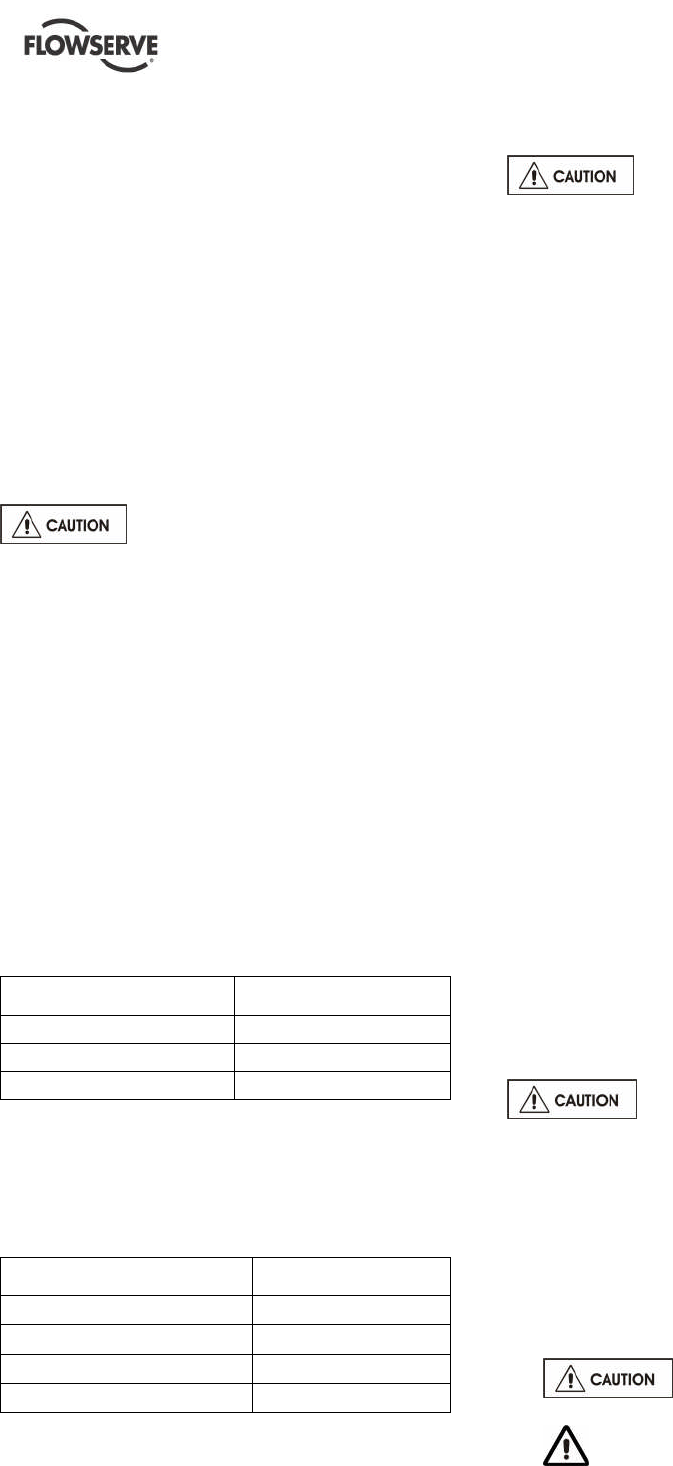
FM USER INSTRUCTIONS ENGLISH 71576526 - 03/07
Page 21 of 32 flowserve.com
Set the alarm at (t+tb-ta+5) C [(t+tb-ta+10) F]
and the trip at 100 C (212 F) for oil lubrication
and 105 C (220 F) for grease lubrication
It is important, particularly with grease lubrication, to
keep a check on bearing temperatures. After start up
the temperature rise should be gradual, reaching a
maximum after approximately 1.5 to 2 hours. This
temperature rise should then remain constant or
marginally reduce with time.
5.5.5 Normal vibration levels, alarm and trip
For guidance, pumps generally fall under a
classification for rigid support machines within the
International rotating machinery standards and the
recommended maximum levels below are based on
those standards.
Alarm and trip values for installed
pumps should be based on the actual
measurements (N) taken on site on the bearing
housings of the pump in the fully commissioned as
new condition.
The example (N) value is given for the preferred
operating flow region (typically this may extend to 70
to 120 % of the pump best efficiency point); outside
the preferred flow region the actual vibration
experienced may be multiplied by up to 2.
These standard values can vary with the rotational
speed and the power absorbed by the pump. For
any special case, do not hesitate to consult us.
Measuring vibration at regular intervals will then
show any deterioration in pump or system operating
conditions.
Vibration Velocity -
unfiltered
Horizontal Configuration
mm/s (in./s) r.m.s.
Normal N 5.6 (0.22)
Alarm N x1.25 7.1 (0.28)
Shutdown Trip N x2.0 11.2 (0.44)
5.5.6 Stop/start frequency
Pump sets are normally suitable for the number of
equally spaced stop/starts per hour shown in the table
below. Check actual capability of the driver and
control/starting system before commissioning.
Motor rating kW (hp)
Maximum start ups per
hour
Up to 15 (20) 15
Between 15 (20) and 90 (120) 10
90 (120) to 150 (200) 6
Above 150 (200) Refer
Where duty and standby pumps are installed it is
recommended that they are run alternately every
week.
5.6 Stopping and shutdown
According to hydraulic conditions of
the installation and its automation degree, stop and
restart procedures can have different forms.
Nevertheless all of them must respect imperatively
the following rules:
5.6.1 Stopping < 1 hour
a) Isolate motor.
b) Avoid reverse rotation of the pump.
c) Make sure that the discharge line pressure does
not reach the foot valve.
5.6.2 Stopping < 1 month
a) Isolate motor.
b) Avoid reverse rotation of the pump.
c) Make sure that the discharge line pressure does
not reach the foot valve.
d) Close the outlet valve. Eventually close the inlet
valve.
e) Switch off external power supply,
flushing/quench, cooling liquid.
5.6.3 Shutdown > 1 month
a) Isolate motor.
b) Avoid reverse rotation of the pump.
c) Make sure that the discharge line pressure does
not reach the foot valve.
d) Close the outlet valve. Eventually close the inlet
valve.
e) Switch off external power supply,
flushing/quench, cooling liquid.
f) Keep the pump fully filled with water. In case of
pumped liquid other than water, drain the pump
entirely.
g) Turn once per week the pump shaft of one or
two turns.
h) Never restart the pump without carrying out the
verifications recommended before starting (see
§ 5.4.1).
When ambient temperatures are
likely to drop below freezing point, the pump and any
cooling and flushing arrangements must be drained
or otherwise protected.
5.6.4 Restarting in continuous running
a) Ensure that the pump is completely full of liquid.
b) Ensure a continuous supply with a sufficient
available NPSH.
c) Ensure a backpressure so that the motor power
is not in excess.
d) Respect the starting frequency
imposed by the motor manufacturer.
e) Protect the pump against water hammer
when stopping or starting.


















